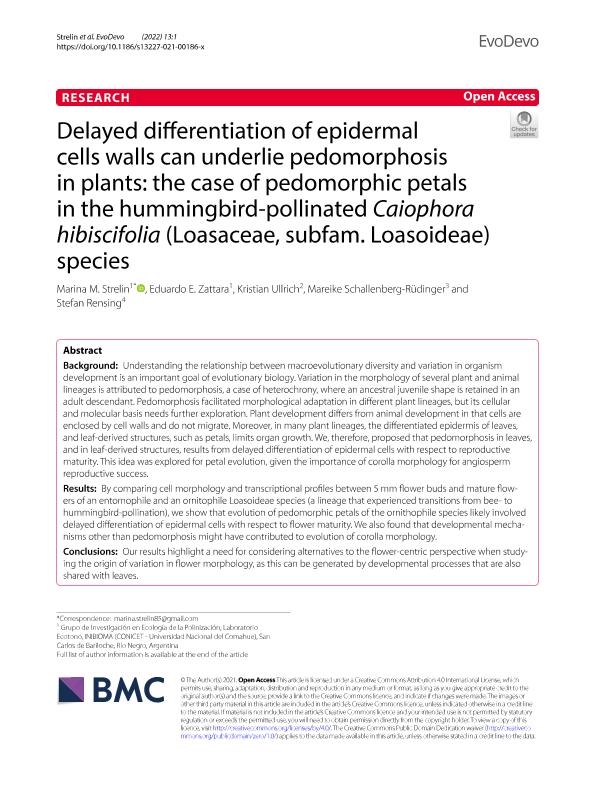Mostrar el registro sencillo del ítem
dc.contributor.author
Strelin, Marina Micaela

dc.contributor.author
Zattara, Eduardo Enrique

dc.contributor.author
Ullrich, Kristian
dc.contributor.author
Schallenberg Rüdinger, Mareike
dc.contributor.author
Rensing, Stefan
dc.date.available
2023-08-01T19:15:12Z
dc.date.issued
2022-01
dc.identifier.citation
Strelin, Marina Micaela; Zattara, Eduardo Enrique; Ullrich, Kristian; Schallenberg Rüdinger, Mareike; Rensing, Stefan; Delayed differentiation of epidermal cells walls can underlie pedomorphosis in plants: the case of pedomorphic petals in the hummingbird-pollinated Caiophora hibiscifolia (Loasaceae, subfam. Loasoideae) species; BioMed Central; EvoDevo; 13; 1; 1-2022; 1-14
dc.identifier.uri
http://hdl.handle.net/11336/206422
dc.description.abstract
Background: Understanding the relationship between macroevolutionary diversity and variation in organism development is an important goal of evolutionary biology. Variation in the morphology of several plant and animal lineages is attributed to pedomorphosis, a case of heterochrony, where an ancestral juvenile shape is retained in an adult descendant. Pedomorphosis facilitated morphological adaptation in different plant lineages, but its cellular and molecular basis needs further exploration. Plant development differs from animal development in that cells are enclosed by cell walls and do not migrate. Moreover, in many plant lineages, the differentiated epidermis of leaves, and leaf-derived structures, such as petals, limits organ growth. We, therefore, proposed that pedomorphosis in leaves, and in leaf-derived structures, results from delayed differentiation of epidermal cells with respect to reproductive maturity. This idea was explored for petal evolution, given the importance of corolla morphology for angiosperm reproductive success. Results: By comparing cell morphology and transcriptional profiles between 5 mm flower buds and mature flowers of an entomophile and an ornitophile Loasoideae species (a lineage that experienced transitions from bee- to hummingbird-pollination), we show that evolution of pedomorphic petals of the ornithophile species likely involved delayed differentiation of epidermal cells with respect to flower maturity. We also found that developmental mechanisms other than pedomorphosis might have contributed to evolution of corolla morphology. Conclusions: Our results highlight a need for considering alternatives to the flower-centric perspective when studying the origin of variation in flower morphology, as this can be generated by developmental processes that are also shared with leaves. Graphical Abstract: [Figure not available: see fulltext.]
dc.format
application/pdf
dc.language.iso
eng
dc.publisher
BioMed Central

dc.relation
https://ri.conicet.gov.ar/handle/11336/197414
dc.rights
info:eu-repo/semantics/openAccess
dc.rights.uri
https://creativecommons.org/licenses/by/2.5/ar/
dc.subject
CELL SHAPE
dc.subject
EPIDERMIS DIFFERENTIATION
dc.subject
FLOWER EVOLUTION
dc.subject
HETEROCHRONY
dc.subject
LOASOIDEAE
dc.subject
PEDOMORPHOSIS
dc.subject
PETAL
dc.subject
POLLINATION
dc.subject
TRANSCRIPTOME
dc.subject.classification
Biología

dc.subject.classification
Ciencias Biológicas

dc.subject.classification
CIENCIAS NATURALES Y EXACTAS

dc.subject.classification
Ciencias de las Plantas, Botánica

dc.subject.classification
Ciencias Biológicas

dc.subject.classification
CIENCIAS NATURALES Y EXACTAS

dc.title
Delayed differentiation of epidermal cells walls can underlie pedomorphosis in plants: the case of pedomorphic petals in the hummingbird-pollinated Caiophora hibiscifolia (Loasaceae, subfam. Loasoideae) species
dc.type
info:eu-repo/semantics/article
dc.type
info:ar-repo/semantics/artículo
dc.type
info:eu-repo/semantics/publishedVersion
dc.date.updated
2023-06-29T10:29:40Z
dc.identifier.eissn
2041-9139
dc.journal.volume
13
dc.journal.number
1
dc.journal.pagination
1-14
dc.journal.pais
Reino Unido

dc.journal.ciudad
Londres
dc.description.fil
Fil: Strelin, Marina Micaela. Consejo Nacional de Investigaciones Científicas y Técnicas. Centro Científico Tecnológico Conicet - Patagonia Norte. Instituto de Investigaciones en Biodiversidad y Medioambiente. Universidad Nacional del Comahue. Centro Regional Universidad Bariloche. Instituto de Investigaciones en Biodiversidad y Medioambiente; Argentina
dc.description.fil
Fil: Zattara, Eduardo Enrique. Consejo Nacional de Investigaciones Científicas y Técnicas. Centro Científico Tecnológico Conicet - Patagonia Norte. Instituto de Investigaciones en Biodiversidad y Medioambiente. Universidad Nacional del Comahue. Centro Regional Universidad Bariloche. Instituto de Investigaciones en Biodiversidad y Medioambiente; Argentina
dc.description.fil
Fil: Ullrich, Kristian. Department of Evolutionary Biology; Alemania
dc.description.fil
Fil: Schallenberg Rüdinger, Mareike. Universitat Bonn; Alemania
dc.description.fil
Fil: Rensing, Stefan. Philipps-universität Marburg; Alemania
dc.journal.title
EvoDevo
dc.relation.alternativeid
info:eu-repo/semantics/altIdentifier/url/https://evodevojournal.biomedcentral.com/articles/10.1186/s13227-021-00186-x
dc.relation.alternativeid
info:eu-repo/semantics/altIdentifier/doi/http://dx.doi.org/10.1186/s13227-021-00186-x
Archivos asociados
